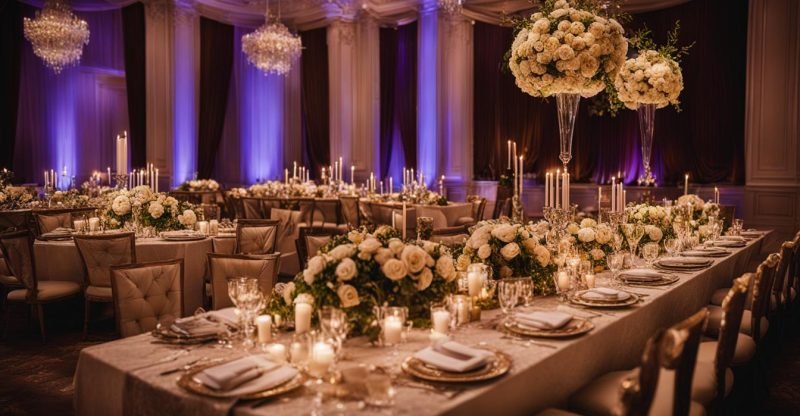Mastering Wedding Seating Etiquette – A Complete Guide
Planning a wedding involves many details, and one important aspect is wedding reception seating etiquette. While assigned seating is not mandatory, it is a common practice that can simplify the dinner service and ensure each table is filled. Wedding venues often require assigned seating, so consulting with the venue can help determine where to seat your guests. Creating the seating chart can be a fun activity and an opportunity to consider the comfort and relationships of your loved ones.
Key Takeaways:
- Assigned seating at a wedding reception is common and can simplify dinner service.
- Consulting with the wedding venue can help in determining the seating arrangements for your guests.
- Creating the seating chart can be a fun activity and allows you to consider the comfort and relationships of your loved ones.
- Proper seating arrangements can enhance the overall atmosphere and interaction at the reception.
- Consider using online tools and seeking inspiration from wedding magazines or other weddings attended to create your seating plan.
Why Wedding Reception Seating Matters
When it comes to planning your wedding reception, don’t underestimate the importance of seating arrangements. Your seating plan can greatly impact the overall vibe and interaction among your guests. By carefully considering the comfort of your guests and creating a harmonious atmosphere, you can ensure that everyone has a memorable and enjoyable experience. Here are some tips to help you master the art of wedding reception seating:
Consider Table Shapes
The shape of your tables can significantly influence the dynamics and interaction among your guests. Round tables are great for promoting conversation and a sense of intimacy, while long rectangular tables can encourage a more formal atmosphere. Think about the type of atmosphere you want to create and choose your table shapes accordingly.
Create a Seating Chart
A seating chart is a helpful tool to ensure that everyone has a seat and that nobody is overlooked. Start by categorizing your guests into groups, such as family, friends, and colleagues. Consider their relationships and interests when assigning seats, and try to seat people who know each other well together. This will help create a familiar and relaxed environment.
Utilize Online Tools
Creating a seating plan can be a daunting task, but there are online tools available that can make the process easier. These tools allow you to assign individual seats within the tables, ensuring that everyone has a designated place. Additionally, you can seek inspiration from wedding magazines, Pinterest, or other weddings you have attended to get ideas for themes, decorations, and layout.
Remember, wedding reception seating is not just about filling up tables. It’s about creating an atmosphere where your guests feel comfortable and can easily interact with one another. By following these tips and being thoughtful in your seating arrangements, you can set the stage for a truly memorable celebration.
Section 3: The Head Table: The Couple and the Bridal Party
When it comes to wedding reception seating etiquette, the head table holds a special place. Traditionally, it is reserved for the couple and their bridal party, serving as a focal point for the reception. The head table arrangement symbolizes the unity and camaraderie of the wedding party, showcasing their special roles and contributions to the celebration.
Typically, the couple sits in the middle of the head table, with the groom to the bride’s right and the maid of honor and bridesmaids on their respective sides. This arrangement creates a visually pleasing balance and allows for easy interaction among the couple and their closest friends and family members. However, modern weddings have embraced alternatives, such as the sweetheart table, where only the couple sits, providing them with a more intimate and private setting.
It is important to consider the dynamics and preferences of the couple and their bridal party when deciding on the head table arrangement. Some couples may choose to include their best man, groomsmen, or even close family members at the head table. Additionally, special considerations should be given to step-parents, ensuring they feel included and respected.
The Head Table Seating Arrangement:
| Position | Person |
|---|---|
| 1 | Bride |
| 2 | Groom |
| 3 | Maid of Honor |
| 4 | Bridesmaid |
Remember, flexibility is key when it comes to wedding reception seating. Some couples may choose to forego the traditional head table altogether and opt for a more relaxed seating arrangement, mingling with their guests at various tables throughout the reception. Ultimately, the goal is to create a seating plan that reflects the couple’s preferences and allows them and their bridal party to enjoy the celebration to the fullest.
Section 4: Parents’ Tables: Honoring the Pillars of Support
When it comes to seating arrangements for your wedding reception, it is important to give special consideration to your parents and immediate family members. They have played a significant role in your life and deserve to have prime seats at the celebration. By seating them at a table closest to you and your partner, you can ensure that they are honored and given clear views of the festivities.
Parents’ Tables: Honoring the Pillars of Support
In cases where there may be divorced or separated parents, it is essential to be sensitive to their needs and feelings. Separate tables can be arranged to ensure their comfort and to avoid potential awkwardness. Remember, this day is about celebrating your love, and it is important to create an atmosphere of joy and inclusivity for all.
Here is a suggested seating arrangement for the parents’ tables:
| Table 1 | Table 2 |
|---|---|
| Mother of the Bride | Mother of the Groom |
| Father of the Bride | Father of the Groom |
| Siblings of the Bride | Siblings of the Groom |
| Other immediate family members | Other immediate family members |
Remember, while this seating arrangement is a suggested guideline, it is essential to consider the specific dynamics and relationships within your own family. The goal is to ensure that everyone feels valued and has a wonderful time celebrating your special day.
Section 5: Grandparents’ Seating: Acknowledging the Elders
When it comes to seating arrangements for a wedding reception, it’s important to honor and acknowledge the role of grandparents. Including them in the seating plan shows respect and appreciation for their presence on this special day. Here are some seating chart tips for including grandparents:
- Consider their mobility needs: Take into account any mobility issues that grandparents may have. Seat them at a table that is easily accessible and close to the main events of the reception.
- Choose a seating arrangement: You have options when it comes to seating grandparents. They can be seated at the parents’ table, where they can be close to the couple and immediate family members. Alternatively, you can assign them their own table nearby, ensuring they have a comfortable and enjoyable experience.
- Ensure clear views: Regardless of where they are seated, make sure grandparents have clear views of the festivities. Place them in a location where they can fully engage and participate in the celebration.
Remember, grandparents hold a special place in wedding celebrations. By including them in the seating arrangement, you are acknowledging their importance and making them feel valued on this joyous occasion.
| Table | Guests |
|---|---|
| Table 1 | Grandparents of the Bride |
| Table 2 | Grandparents of the Groom |
| Table 3 | Other Grandparents |
Table: Sample seating arrangement for grandparents
Creating a thoughtful and considerate seating plan that includes grandparents will ensure their presence is celebrated and cherished throughout your wedding reception.
Section 6: Friends and Extended Family: Encouraging Camaraderie
Seating friends and extended family together at your wedding reception is a great way to foster a sense of camaraderie and create a warm, inviting atmosphere. By grouping guests based on their relationships or common interests, you can encourage conversation and make everyone feel more comfortable.
Consider creating a seating plan that strategically places guests who know each other well at the same table. This will help create a familiar and relaxed environment, as they can catch up and reminisce. You can also use this opportunity to introduce friends and extended family members who may not have had the chance to meet before. By seating individuals with similar backgrounds or hobbies together, you’ll give them a common thread to connect over.
Remember, the goal is to facilitate an enjoyable experience for everyone. To ensure your friends and extended family have a great time, consider including conversation starters or icebreaker activities at each table. This can help break the ice and get the conversations flowing.
Table 6.1: Friends and Extended Family Seating
| Table | Guests |
|---|---|
| Table 1 | Margaret, Sarah, Emily, David |
| Table 2 | Michael, Samantha, Jessica, Jason |
| Table 3 | Robert, Sarah, Elizabeth, Benjamin |
| Table 4 | Christopher, Jennifer, Daniel, Rebecca |
By carefully considering the seating arrangements for your friends and extended family, you can create an atmosphere of connection and camaraderie that will make your wedding reception truly memorable for everyone.
Section 7: Colleagues and Professional Contacts: Mixing Business with Pleasure
When it comes to seating colleagues and professional contacts at a wedding reception, it’s important to create an environment that allows them to relax and enjoy themselves outside of the work setting. By strategically seating them together, you can foster meaningful conversations and potentially strengthen professional relationships. However, it’s crucial to consider dynamics and avoid potential tension that may arise.
One approach is to seat colleagues and professional contacts at a separate table away from the work environment. This allows them to engage with each other in a more informal and social setting. Consider their personalities, interests, and connections when determining who should be seated together. Placing clients or business partners with others who share common interests or can provide mutual benefits can facilitate more engaging conversations and positive interactions.
Additionally, keep in mind the seating protocols for colleagues and professional contacts. It’s important to give them a suitable place at the reception without overshadowing other key guests. Proper etiquette suggests seating them in a location that balances their importance with the overall seating arrangement. This ensures that they feel acknowledged and respected while still allowing them to enjoy the celebration.
Colleagues and Professional Contacts Seating Example
| Table No. | Guests |
|---|---|
| Table 1 | John Smith |
| Sarah Johnson | |
| David Wilson | |
| Table 2 | Karen Thompson |
| Michael Brown | |
| Emily Davis |
In the example above, John Smith, Sarah Johnson, and David Wilson are seated together at Table 1, while Karen Thompson, Michael Brown, and Emily Davis are seated together at Table 2. This arrangement allows colleagues to engage with each other in a relaxed and enjoyable manner, fostering camaraderie and potentially creating new connections.
By carefully considering the seating arrangements for colleagues and professional contacts, you can strike a balance between business and pleasure, creating an atmosphere that encourages meaningful interactions and a memorable wedding reception.
Singles’ Table: Facilitating New Connections
At a wedding reception, seating arrangements play a crucial role in creating a comfortable and engaging atmosphere for all guests. And when it comes to singles attending the event, a dedicated singles’ table can be a fantastic way to encourage new connections and foster a memorable experience.
By strategically seating single friends together, you provide them with an opportunity to meet and interact with new people who share similar interests and backgrounds. This arrangement can lead to genuine connections and even potential romances. The singles’ table acts as a social hub, bringing together individuals who may have otherwise felt left out or unsure about mingling with other guests.
When setting up the singles’ table, consider the dynamics and personalities of the singles attending. Aim to create a harmonious mix of personalities and interests to increase the chances of sparking meaningful conversations. Providing conversation starters, such as interesting table topics or icebreaker games, can also help break the ice and encourage interaction among guests.
Example Singles’ Table Seating Plan:
| Seat | Guest Name |
|---|---|
| 1 | Emily |
| 2 | Michael |
| 3 | Olivia |
| 4 | Nathan |
| 5 | Sarah |
| 6 | David |
| 7 | Grace |
Remember that while seating singles together can enhance their experience, it’s essential to make everyone feel comfortable and respected. Avoid any negative stereotypes or labels associated with being single. Instead, focus on creating an inclusive and enjoyable environment where guests can build connections, celebrate love, and have a wonderful time.
Singles’ Table: Facilitating New Connections
The singles’ table is a great opportunity to create a fun and engaging space for single guests to connect and mingle. By strategically seating them together, you can foster new friendships and even spark potential romance. Here are some seating chart tips to make the singles’ table a hit:
- Consider the age and interests of your single guests. Seat them together based on commonalities to encourage conversation and connection.
- Include a mix of genders to create a balanced dynamic. This allows for diverse interactions and avoids any potential feelings of exclusion.
- Place outgoing and sociable individuals at the singles’ table. They can help break the ice and initiate conversations, ensuring everyone feels included.
- Provide conversation starters or unique icebreaker games at the table. This can help guests feel more comfortable and encourage interaction.
The singles’ table should be a lively and inviting space where guests can enjoy each other’s company. By following these seating chart tips, you can create an atmosphere that fosters new connections and adds an element of excitement to your wedding reception.
Table 1: Example Seating Arrangement at the Singles’ Table
| Seat | Name | Age | Interests |
|---|---|---|---|
| 1 | Emily | 28 | Travel, hiking |
| 2 | Michael | 31 | Photography, cooking |
| 3 | Sarah | 25 | Art, yoga |
| 4 | David | 29 | Music, sports |
| 5 | Amy | 27 | Books, dancing |
“The singles’ table gave me the chance to meet new people and make lasting connections. I had a great time getting to know others who were in a similar situation, and it really added to the overall enjoyment of the wedding reception.” – Emily
Section 10: Creating a Seating Plan
When it comes to planning the seating arrangements for your wedding reception, a well-thought-out seating plan can ensure a smooth and enjoyable experience for both you and your guests. With a few simple steps, you can create a seating plan that accommodates everyone while fostering a pleasant atmosphere. Here’s how:
Step 1: Create a Floor Plan
Begin by creating a floor plan of your reception venue. Consider the layout of the space, including entrances, exits, dance floor, and any other essential elements. This will help you determine the best placement for tables and ensure easy flow and accessibility throughout the event.
Step 2: Start with the Head Table
Once you have your floor plan, start by placing the head table. The head table traditionally includes the couple and their bridal party. Determine whether you’ll have a traditional head table or opt for a sweetheart table. Position the head table in a central location, with a clear view of the rest of the room.
Step 3: Seat Parents and Immediate Family
Next, assign seats for parents and immediate family members. These individuals should have prime seats, often at tables closest to the head table. Consider any divorced or separated parents and ensure their comfort by arranging separate tables if needed.
Step 4: Seat Friends, Extended Family, and Other Guests
Once your immediate family is seated, it’s time to seat your friends, extended family, and other guests. Group people together based on relationships or common interests to encourage conversation and create a relaxed environment. Consider seating clients or business partners with interesting or beneficial individuals to strengthen professional relationships.
By following these steps, you can create a seating plan that accommodates your guests’ needs and fosters a harmonious atmosphere for your wedding reception.
| Step | Description |
|---|---|
| Step 1 | Create a floor plan of the venue, considering layout and essential elements. |
| Step 2 | Place the head table in a central location, ensuring a clear view of the room. |
| Step 3 | Seat parents and immediate family members at prime tables, considering any divorce or separation. |
| Step 4 | Seat friends, extended family, and other guests based on relationships or common interests. |
Utilizing Tools and Seeking Inspiration
When it comes to creating a seating plan for your wedding reception, there are plenty of tools and sources of inspiration that can help you along the way. Online seating chart generators can be incredibly useful in assigning individual seats within the tables, ensuring that everyone has a designated place. These tools often come with customizable features that allow you to create a detailed and visually engaging seating chart. Consider using platforms like AllSeated or Social Tables to streamline the process and make it easier to manage.
Additionally, seeking inspiration from various sources can spark your creativity and help you design a seating chart that aligns with your wedding theme and vision. Wedding magazines, Pinterest, and even other weddings you have attended can provide you with valuable insights and ideas. Experiment with different themes, decorations, and layouts, and don’t be afraid to think outside the box. Remember, your seating chart should reflect the personality and style of you and your partner.
Table: Online Seating Chart Generators
| Tool | Features | Pricing |
|---|---|---|
| AllSeated | Customizable seating charts, guest list management, Virtual Reality capabilities | Free basic plan, premium plans starting at $9.99/month |
| Social Tables | Drag and drop functionality, 3D diagramming, collaboration tools | Pricing available upon request |
Remember to always keep your guests’ comfort and relationships in mind when finalizing your seating plan. A well-thought-out arrangement can enhance the overall atmosphere and interaction at your reception, ensuring that everyone has a memorable and enjoyable experience.
Conclusion
Wedding reception seating etiquette is an important aspect of planning a successful wedding. By following these guidelines and considering the comfort and relationships of guests, you can create a memorable and enjoyable experience for everyone. Proper seating arrangements can enhance the overall atmosphere and interaction at the reception.
Remember that assigned seating is not mandatory but is common, especially in venues that require it. Consulting with the venue can provide valuable insights on where to seat your guests. Creating a seating chart can be a fun activity that allows you to personalize the experience.
Whether it’s the head table, parents’ tables, grandparents’ seating, or seating for friends and extended family, each arrangement serves a purpose. By honoring the pillars of support and acknowledging the elders, you show respect and appreciation for their role. Seating guests together based on relationships or common interests encourages camaraderie and creates a relaxed environment.
Don’t forget to utilize tools and seek inspiration from online resources such as wedding magazines and Pinterest. Experiment with themes, decorations, and layouts to create a seating plan that reflects your vision and adds to the overall ambiance of your wedding reception.
FAQ
Is assigned seating mandatory at a wedding reception?
Assigned seating is not mandatory, but it is common. It ensures each table is filled and simplifies plated dinner service.
Can the wedding venue help determine where to seat guests?
Yes, consulting with the venue can help determine where to seat guests and ensure a smooth flow of the reception.
What is the purpose of creating a seating chart?
Creating a seating chart helps to ensure everyone has a place and nobody is overlooked during the reception.
How does the seating arrangement at a wedding reception influence the overall atmosphere?
The seating arrangement can influence the overall vibe and interaction among guests. It is important to consider the comfort of guests and create a harmonious atmosphere.
What are some factors to consider when seating guests?
Factors to consider include table shapes, such as round or rectangle, which can affect the dynamics and interaction among guests. It is also important to consider the relationships and common interests of guests.
Who traditionally sits at the head table?
The head table is traditionally reserved for the couple and their bridal party. Modern weddings may opt for a sweetheart table where only the couple sits.
How should parents and immediate family members be seated?
Parents and immediate family members should have prime seats at the reception, often seated at the table closest to the couple. In cases of divorce or separation, separate tables can be arranged for their comfort.
Where should grandparents be seated?
Grandparents can be seated at the parents’ table or have their own table nearby. It is important to consider their mobility needs and show respect for their role in the celebrations.
How should friends and extended family be seated?
Friends and extended family should be seated together based on relationships or common interests. This encourages conversation and makes everyone feel more comfortable.
How should work colleagues and professional contacts be seated?
Work colleagues and professional contacts should be seated together, away from the work environment. Consider dynamics and avoid potential tension. Seating them with interesting or beneficial people can strengthen professional relationships.
Should there be a separate table for children?
If there are several children attending, a separate children’s table can be set up. This keeps them together and allows for age-appropriate activities.
Is it common to have a singles’ table?
Yes, a singles’ table is a fun way to seat single friends together and encourage new connections.
How can I create a seating plan?
Begin by creating a floor plan of the venue and marking essential elements. Start with the head table and work your way outwards, placing guests. Take advantage of online tools to make the process easier.
Where can I find inspiration for seating arrangements?
You can seek inspiration from wedding magazines, Pinterest, or other weddings you have attended. Experiment with themes, decorations, and layouts to create a personalized seating chart.







